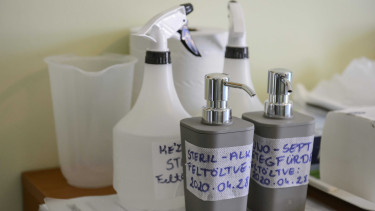Sparks that could ignite the fourth wave in the coronavirus pandemic in Hungary

The fourth wave a comin'
Only a month ago, experts gave cautious answers when asked about the possibility of a fourth wave in the coronavirus pandemic. By now, a resurgence of SARS-CoV-2 cases is the baseline scenario for most of them. Consequently, we need to take a very close look at what could lead to a fourth wave in Hungary.
Over the last few weeks, one expert (virologists, biologists) after another warned that a fourth wave in Hungary is inevitable, highlighting the more transmissible (+40-60%) Delta variant (B.1.617.2), and that the local vaccination campaign has practically come to a halt at 5.5 million people inoculated with a first dose of a COVID-19 vaccine. There are various examples around the globe that should open our eyes to a daunting reality.
Prime Minister Viktor Orbán has also mentioned an interview with public radio MR1 last Friday that he regularly consults with epidemiologists and that the fourth wave in the pandemic is expected to strike in September or October.
He soothed fears by saying that vaccines are effective, and even if those fully immunised get the virus, the symptoms are likely to be moderate. He added that the country is fully prepared for the fourth wave and that they were assessing how many hospital beds and ventilators could be needed.
He warned that if you do not get your shots, you cannot hide from this infection, stressing that millions of Hungarians are not yet vaccinated.
Unpleasant scenery elsewhere
The Delta variant is creating challenges also for countries with a high vaccination rate. The health care system of Chile is close to reaching its top capacity and daily COVID-19 deaths are stagnating at a high level. The Delta variant of Covid-19 continues to spread in the UK with a further 50,824 cases logged on Friday, marking a 46% increase over the previous week. Of the 50,824 cases 42 are from the Delta AY.1 sub lineage with the mutation K417N which is feared to be more vaccine resistant.
When the UK coronavirus variant (B.1.1.7) was first discovered in the United Kingdom, it took Hungary about two months to produce the same patterns. If the same should happen with the Delta variant, five to six weeks of those two months have already passed, which means it should make a clearly visible entrance by mid-July.
The epidemiological statistics show that Delta continues to spread in Germany, Vietnam, Spain, and Russia. In Israel, about half of the people who have recently contracted SARS-CoV-1 had been previously vaccinated, also because of the Delta variant, and the share of serious cases has also started to climb. The hospitalisation rate was around 5% at the UK variant (Alpha) and it is around 11% at Delta.
Another key message of the foreign examples is that the protection offered by one dose is almost nothing against new variants, or at least Delta.
What are the key risks for Hungary?
- Delta
The Delta variant is more contagious than other variants and evidence indicates it is between 40% to 60% more transmissible than the dominant Alpha strain (UK or Kent variant), itself already 50% more transmissible than the original strain first detected in Wuhan. The basic reproduction value (R0) of the original strain was around 2.5, that of Alpha was around 3.9, whereas researcher estimate the R0 or Delta at between 5.0 and 7.8. Delta is apparently also increasing the risk of hospitalisation.
Perhaps even more importantly, the average age of those infected with Delta is going lower and lower, which is why the UK and Israel should be watched closely to see how the most vulnerable groups (elderly, people with chronic diseases) and younger people are affected.
The European Centre for Disease Prevention and Control (ECDC) has recently warned that based on preliminary data, the Delta variant “can also infect individuals that have received only one dose of the currently available vaccines."
It is very likely that the Delta variant will circulate extensively during the summer, particularly among younger individuals that are not targeted for vaccination
, said ECDC Director Dr. Andrea Ammon in a statement.
"This could cause a risk for the more vulnerable individuals to be infected and experience severe illness and death if they are not fully vaccinated," she added.
The ECDC warned that
THE PROBABILITY THAT SARS-COV-2 DELTA VOC BECOMES RAPIDLY DOMINANT IN THE EU/EEA IS CONSIDERED VERY HIGH.
- Vaccination
Whereas Hungary has once been the European champion in the administration of COVID-19 vaccines, relying on eastern shots as well (Russia’s Sputnik V, China’s Sinopharm) while other EU member states stuck to vaccines approved by the European Medicines Agency (EMA), the vaccination campaign has first slowed down radically and by now it has practically come to a halt at 5.5 million people vaccinated with at least one jab.
Hungary is still a far cry from a 75-80% threshold that is not even the herd immunity threshold only a kind of stronger impediment to the spread of coronavirus.
The vaccination rate of the different age groups and the most vulnerable groups shows great differences between Hungary and other countries. In the UK, and in Israel, nearly 100% of the elderly population is vaccinated against COVID-19. The latest ECDC data show that only about 71% of the 80+ population (17th in the world), 82% of the 70-19 age group (14th) and less than 72% of the 60-69 age group (15th) are vaccinated against coronavirus (scroll down for more detailed chart with said data). Several European countries have already inoculated 90 to 100% of their elderly population.

- Vaccine efficacy
The efficacy of China’s Sinopharm vaccine have been put into question lately, with a report that one in three people inoculated with this shot had neither antibodies or T-cells and so are not protected from SARS-CoV-2.
ECDC data show that two million doses of Sinopharm have been administered in Hungary (including those with two and those with only one jab). This means that at least one million people have received Sinopharm (two doses), but the actual number is higher because many never turned out for their second dose, they merely wanted to obtain their immunity certificate.

Sinopharm was first put to use in the 60+ age group in late February 2021, and the doubts about its efficasy imply that even a smaller share of the population is protected than what official figures show. The right-hand chart below shows the share of the population that received their first and second jabs, as well as the share of the population for whom these shots are actually effective: 14-day average of the daily vaccination rates, as it takes about two weeks to build partial or full immunity after the shots.


There is currently no plan in Hungary to administer booster (third) shots from any vaccine, while the move is considered at least in the UK, Turkey, Bahrein, and Russia. The cabinet keeps mentioning the responsibility of the pharmaceutical companies that manufacture these vaccines, while in some case the government had actually assumed responsibility during the approval process.
Immunologist András Falus said in one of his podcasts that there’s absolutely no reason why a booster shot could not be administered to those that show no immune response even after their second dose.
Also note that there could be up to 500,000 people in Hungary that have not showed up for their second jab. Their protection against new variants is clearly low, although we do not have information on their age distribution which would be relevant when assessing how their potential infection could burden their immune system and eventually the health care system.
Hungarian authorities provide no data on the geographical distribution of vaccinations. But if we look at other countries, we find that low-wage social groups are generally those that do not get vaccinated, and the residents of large cities are more open to getting their jabs. This could imply that a high-mortality pandemic wave will lead to high excess mortality too.
- The kids
The starting of the school year in the autumn could be critical. Whereas the government gave parents the choice of having their children between 12 and 18 vaccinated against COVID-19, it has launched no campaign whatsoever to convince them that they should.
According to end-June data, 59,000 children in the 12-15 age group were registered for a COVID-19 vaccine (minors are inoculated only with Pfizer-BioNTech’s Comirnaty), and 45% of them got their jab. There are about 400,000 children in this age group, i.e. hardly 7% of them have been vaccinated by the end of June.
The ECDC statistics is even worse. As of 2020, there were about 1,808,000 people in the 0-18 age group, according to Central Statistical Office (KSH), and only 5.9% off them have been inoculated against COVID-19 by the end of the 25th week of the year.
And guess where the Delta variant could find new hosts? Yup, in schools in September.

- Vaccine hesitancy
Some people still say.
Nah, thanks, I'm good. I don't need no shot, man. I've got this bug, err, in the second wave. Or was it the third...I dunno. So I have immunology, yeah. Or immunity, whatever. I beat this mofo, that's for sure.
Well, these people should start pondering right about now how long their immunity can last. Sadly, science says their immunity will fade away and will be both on the receiving and giving end of the next wave unless they come to their senses and get their shots.
Oh, and let’s not forget that Hungary has further eased curbs, and as of Saturday you don’t need to wear a mask even indoors, you don’t need your immunity certificate to go to a hotel, the movies or theatre. It’s as if we longed for a debilitating infection, its long-term consequences and/or death. Mental.
- Easing the curbs
Hungary’s stringency index went down to 49.07 points on 19 May and further on 3 July (the chart below shows data up to 28 June).

And this is how it looks like when the left-hand scale is not logarithmic:

And these are only the risks we see and can identify now, while new variants and mutations emerge constantly and some of them could prove more viable, more transmissible and more deadly than the current ones.
So, what can / should be done?
We need to manage the above risks and minimise them as efficiently as possible. Lockdown is the last resort and has the highest costs in economic terms, although if you measure the costs in lives rather than money… There’s probably a wide-ranging consensus that restriction measures should be avoided (e.g. the closure of schools, curfew, closure of stores and services, etc.).
It would be advisable to rev up the vaccination campaign, but it seems like the cabinet has maxed out its efforts when it introduced the immunity certificate, persuading hundreds of thousands of residents to go and get their jab (at least one that is).
Now it’s time for costlier and targeted campaigns.
One, for instance, that is aimed specifically at children and their parents. This could and should include information campaigns in poorer, underdeveloped regions. Specific groups would need to be identified that could be targeted with similar campaigns. It’s not enough to spend billions of forints on billboards depicting semi-celebrities saying “vaccination saves lives”, because these would no longer reach the people that need to be reached.
The Hungarian Chamber of Commerce and Industry (MKIK) urges strict vaccination-related rules when it comes to hiring employees, and corporations could also do a lot to promote vaccination.
Some countries believe that the ‘home delivery’ of vaccines is the solution to reaching and inoculating more people. In France, appointments can be made for two different locations for the first and the second doses. In Belgrade, they administer shots in malls. In the UK, they set up mobile vaccination locations back in May. (Hungary operated vaccination buses in some towns.)
Incentives could be introduced to promote vaccination, which could include not only sanctions for the unvaccinated but positive ‘nudges’ for those that get their shots, including benefits for immunity certificate holders, money (Serbia), vouchers (Bulgaria is considering this move), vaccine lottery (in some American states), reward for employees (paid by some companies in Germany), paid leave.
It should be communicated clearly and persistently that vaccines can effectively prevent severe illness and death. The trust of people in vaccines would need to be bolstered. We’ve seen some reassuring news in terms of vaccine efficacy from the UK most recently.
There should be a well-functioning surveillance system up and running, along with a regular, transparent and public presentation of the spread of the new variants which would show hotspots and the areas and regions where Delta is becoming dominant.
And let’s not forget about personal responsibility. Experts agree that if everyone kept the most basic social distancing and hygiene guidelines, and wore masks indoors, coronavirus would have a lot smaller chances of spreading.
If you wore a mask on Friday (2 July) when 5,495,888 people were vaccinated against COVID-19 (with a first dose), why would you choose to go indoors (shopping, cinema, bar) without your mask when there are only 4,123 more people vaccinated with their first jab and about 4.3 million unvaccinated people in the country? Just because the government says you can? Come on!
The Swiss Cheese Model offers a multi-layer prevention strategy. While the layers are insufficient in themselves, putting them on top of each other gives you a rather good chance of avoiding infection and its consequences.

Cover photo: MTI/Tamás Vasvári





